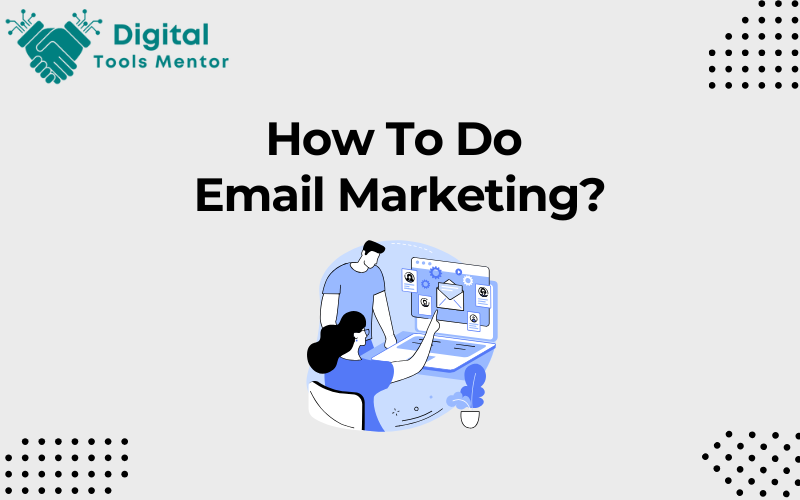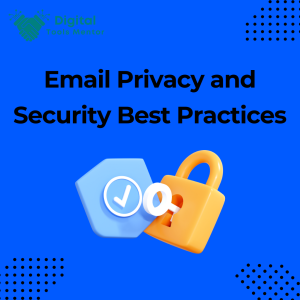How To Do Email Marketing?
Email marketing has emerged as a crucial component of a successful digital marketing strategy. It offers businesses a direct and personalized means of communication with their target audience. By leveraging email campaigns, companies can engage customers, drive sales, and build brand loyalty. However, effective email marketing requires a well-thought-out approach. This guide outlines the 11 key steps involved in starting an email marketing campaign as each step plays a vital role in ensuring the success of your email marketing efforts. By following these steps, businesses can harness the power of email marketing to connect with their audience and achieve their marketing objectives.
How To Do Email Marketing: 11 Steps You Need To Start Email Marketing
- Define your audience
- Set goals
- Choose an email marketing platform
- Determine campaign type
- Build an email list
- Segment your list
- Create your email
- Spend time on subject lines
- Test your email
- Send your email (at the best time)
- Measure your results
How To Do Email Marketing: Step-By-Step Guide
1. Define Your Audience
The first step in email marketing is to clearly define your target audience. Every successful marketing campaign starts with understanding its audience. For email marketing, this means understanding who will be receiving, reading, and hopefully, acting on your emails. Are they existing customers? Prospective clients? Industry peers? Depending on your business and goals, you might need to create several audience profiles. Factors like age, location, job role, buying habits, challenges, and preferences can shape the content and design of your emails. When you truly know your audience, you can tailor your messaging to resonate more deeply, leading to higher engagement and conversion rates.
2. Set Goals
Before sending out a single email, be clear about what you aim to achieve. Is it brand awareness, increased sales, driving traffic to a new blog post, or maybe gathering feedback? Perhaps you’re looking to nurture leads, or you want to upsell to existing customers. Setting clear, measurable goals at the outset not only provides direction for your campaign but also benchmarks to measure success against. For instance, a goal might be “Increase website traffic by 20% from email links over the next quarter” or “Achieve a 10% conversion rate on the new product promotion.” By having set metrics, you can later assess the effectiveness of your campaign and refine your strategies.
3. Choose An Email Marketing Platform
Selecting a reliable email marketing platform is crucial for managing and automating your email campaigns. Look for platforms that offer features like contact management, email templates, analytics, and automation capabilities. Consider factors such as pricing, scalability, and integration with other tools that you use in your marketing stack. Your choice should be based on your budget, the size of your email list, the required features (like A/B testing, list segmentation, or automation), and ease of use.
Read Our Blog: 23 Best Email Marketing Platforms in 2025
4. Determine Campaign Type
Depending on your goals, choose the most appropriate campaign type for your email marketing efforts. Common types include promotional emails, newsletters, welcome emails, abandoned cart reminders, and re-engagement campaigns. Each type serves a different purpose and requires a unique approach to content and design. There are various types of email campaigns, each serving a distinct purpose. Newsletters update your audience about recent happenings or content. Promotional emails highlight deals, discounts, or new products. Welcome emails introduce and onboard new subscribers. Transactional emails, like order confirmations and shipping notifications, confirm an action the recipient has taken. Educational emails provide information or resources that might be of value to the subscriber. Choosing the right campaign type is crucial, as it dictates the content, tone, and call to action you’ll include. It’s essential to match your campaign type with the goals you’ve set.
5. Build An Email List
Building a robust and relevant email list is foundational. Start by integrating sign-up forms on your website, especially on high-traffic pages. Offer value in exchange for their email, like a discount, eBook, or access to a webinar. It’s essential to ensure that your subscribers have opted-in to receive emails to avoid issues with spam. Over time, periodically clean your list by removing inactive users or those who haven’t engaged with your emails. This enhances deliverability and engagement metrics.
6. Segment Your List
Segmentation is about categorizing your email subscribers based on shared characteristics, behaviors, or preferences. By segmenting your list, you can tailor your messaging to fit each group more appropriately, increasing the relevance of your emails. Common segmentation criteria include purchase history, location, engagement level, and more. For instance, you wouldn’t send the same email to a first-time visitor as you would to a loyal, long-time customer.
7. Create Your Email
Crafting the perfect email involves balancing compelling content with an attractive design. Ensure your emails are mobile-responsive, as a significant portion of users read emails on mobile devices. Use captivating images, but also make sure the email looks good without them, as some email clients block images. The content should be clear, concise, and aligned with your set goals. Always include a clear call-to-action, guiding the recipient on what you’d like them to do next.
8. Spend Time On Subject Lines
Subject lines play a crucial role in determining whether your emails get opened or end up in the spam folder. Spend time crafting attention-grabbing subject lines that pique curiosity, create urgency, or offer value to the recipient. A well-crafted subject line should be concise, relevant, and compelling, enticing the recipient to open the email.
9. Test Your Email
Before sending your email to your entire list, it’s important to conduct thorough testing. Check the email for any formatting or spelling errors, test different email clients and devices to ensure compatibility, and verify that all links and buttons work properly. Additionally, A/B testing can help you optimize your emails by comparing different elements such as subject lines, content, or call-to-action buttons to identify what resonates best with your audience.
10. Send Your Email (At The Best Time)
Timing is key when it comes to sending your emails. Consider your audience’s time zone, their habits, and your specific goals to determine the optimal time for sending. Test different send times to find the sweet spot that generates the highest open and click-through rates. Keep in mind that the best time to send emails can vary depending on your industry and target audience.
11. Measure Your Results
After sending out your emails, it’s essential to analyze the results. Look at metrics like open rates, click-through rates, conversion rates, and unsubscribe rates. These metrics provide insights into what’s working and what isn’t. If a campaign didn’t achieve its goals, try to understand why. Was the content not engaging enough? Were there issues with the email’s display? Or perhaps it was sent at the wrong time? By consistently measuring and analyzing, you can refine your email marketing strategy, ensuring continual improvement and better results over time.
How To Do Email Marketing: Conclusion
In conclusion, the 11 steps to start email marketing provide a comprehensive framework for building successful email campaigns. It begins with defining your audience, ensuring that your messages resonate with the right recipients. Setting clear goals helps you stay focused and measure the effectiveness of your campaigns. Choosing a suitable email marketing platform enables efficient management and automation of your email efforts. Determining the campaign type allows you to tailor your content and design to achieve specific objectives. Building an email list is essential for reaching your target audience and expanding your reach. Segmenting the list helps you deliver personalized and relevant content. Creating engaging emails with attention-grabbing subject lines enhances open and click-through rates. Thoroughly testing your emails ensures they are error-free and optimized for different devices. Finding the best time to send your emails maximizes their impact. Finally, measuring the results allows you to evaluate the success of your campaigns and make data-driven improvements. By following these steps, businesses can harness the power of email marketing to effectively engage their audience, drive conversions, and achieve their marketing goals.
Top 3 Recommended Email Marketing Tools
1. MailerLite:
A user-friendly and affordable email marketing tool suitable for small to medium-sized businesses. It offers a drag-and-drop editor, automation, landing pages, and excellent customer support.
2. GetResponse:
A comprehensive email marketing platform with a wide range of features, including automation, A/B testing, webinars, and CRM integrations. It caters to businesses of all sizes and provides a user-friendly interface.
3. SendX:
Known for its simplicity and affordability, SendX offers features like email automation, segmentation, and customizable sign-up forms. It’s ideal for startups and small businesses looking for an easy-to-use yet effective email marketing solution.
6 Tips To Improve Your Email Marketing Strategy
Email marketing has a few moving parts, but successful campaigns boil down to these six factors:
1. Use Tools Made for Email Marketing
You can’t run an effective email marketing campaign using a standard email service. Yes, you can send bulk and blast emails from Outlook, Office 365 and Gmail. However, none provide email list building and maintenance tools, list segmentation, attractive email templates, campaign reporting or list scrubbing features.
To achieve business-building results, you need software designed specifically for email marketing or a customer relationship management (CRM) system with email features. We’ll explore some top options for these below.
2. Build Your Email List Proactively
Start building your list by collecting customer email addresses during your sales process or client interactions. However, don’t limit your email list-building opportunities to only these interactions.
You can entice potential leads and customers to give you their email address before they ever spend a dime with you. The secret is using lead magnets. These are value-added freebies, such as e-books, webinars, checklist downloads, free trials and even coupons.
To get new email subscribers, promote lead magnet items on your website, landing pages, social media channels and so on, and require an email sign-up to download or receive the freebie. If the viewer perceives value, they’ll happily provide their email address and opt-in to your email list in exchange.
3. Segment Your List by User Intent
Segmenting divides your email subscriber list by user interest and is a key strategy to email marketing success. Using segmentation, you can target content to specific subscriber groups and deliver real value to readers. Campaigns that use segmentation have higher open rates and fewer unsubscribes compared to those that send generalized messaging to all subscribers.
You can segment email subscribers in several ways, such as by purchasing history, website interactions and lead magnet types. Most email marketing solutions even let you add interesting questions to your signup emails.
Most email marketing tools have customizable email signup forms that help you build segmented lists automatically like this one from Mailchimp.
Many email marketing tools integrate with website and retail platforms for automated segmentation based on sales history and website interactions too.
4. Engage Your Readers at Every Step
Once you have your email subscriber list, you’re ready to create and send content that delivers value to your segmented subscribers. Here, you have five opportunities to engage subscribers and entice them to open, read and perform an action in your email.
From line: Your business or promotion name that subscribers will recognize and trust.
Subject line: The short phrase that catches their eye as they scan their inbox.
Preheader line: Supports the subject line with an added enticement to open the email.
Email content: Short and punchy message such as a promotion, news update or announcement.
Call to action (CTA): Buttons or highlighted links drive click-throughs back to your shopping pages, signup forms or whatever action you wish subscribers to take.
When you send your emails also impacts engagement, opens and clicks. Most experts agree that email marketing should hit inboxes at 10 a.m. or 2 p.m. on business days. Data also shows that Mondays tend to have the highest open rates of 22% on average while weekend open rates run lower at about 20%.
5. Measure Your Email Marketing Campaign Results
After your email marketing message is sent, you’ll be able to review key metrics including the number of email bounces, how many subscribers opened your email and how many clicked on your CTA links and buttons.
If you follow the send at 10 a.m. or 2 p.m. rule, you’ll have a good picture of the success of your campaign within eight to 10 hours. After about a day, new email opens tend to just trickle in.
Tracking and measuring email opens and CTA clicks helps you gauge the messaging that works for your audience. A/B testing different email “from” lines, subject lines, preheaders and CTAs helps you fine-tune and pinpoint which phrasing and offers get your readers to click.
6. Scrub, Rinse and Repeat
Bounced emails happen. It’s just part of the process. This means the email you sent was undeliverable due to a bad email address format, a blocked email or a fake email address. To maintain the health of your email list and improve overall deliverability, bounced emails need to be removed or scrubbed from your list.
Most email marketing systems make this step easy. Once a scrub of bounced emails is complete, you’re ready to jump back up to step four and run another campaign on the schedule you set. Remember to use what you learned from previous campaigns to improve your messaging each time.
Is Email Marketing Easy To Learn?
Email marketing can be relatively easy to learn for some, while others may find it more challenging. It depends on your previous experience, technical skills, and willingness to learn and adapt. Here are some points that highlight the factors that contribute to the ease of learning email marketing:
- Basic Understanding: If you have a basic understanding of how emails work, such as composing, sending, and receiving, you already have a foundation to start learning email marketing.
- User-Friendly Platforms: Many email marketing platforms provide user-friendly interfaces and drag-and-drop editors, making it easier for beginners to create and manage email campaigns without extensive technical knowledge.
- Abundance of Resources: There are numerous online resources, tutorials, and courses available to help you learn the fundamentals of email marketing, including best practices, tips, and strategies.
- Templates and Automation: Email marketing platforms often offer pre-designed email templates and automation features that simplify the process of setting up and scheduling campaigns.
- Data Analytics: Email marketing platforms provide analytics and reports that give valuable insights into the performance of your campaigns, helping you understand what works and what needs improvement.
- Community Support: Many email marketing platforms have active user communities where you can seek advice, ask questions, and learn from the experiences of others.
- Flexibility and Creativity: Email marketing allows for creativity in designing content, subject lines, and calls-to-action, providing room for experimentation and learning from results.
- Email Marketing Blogs and Newsletters: There are several reputable blogs and newsletters focused on email marketing, which regularly share industry updates, case studies, and practical tips.
- Compliance and Regulations: Learning about email marketing regulations (e.g., GDPR, CAN-SPAM Act) is essential to avoid legal issues and maintain ethical practices.
- Continuous Improvement: Email marketing is a skill that improves with time and experience. By analyzing data, learning from mistakes, and adapting strategies, you can refine your approach and achieve better results.
While email marketing can be relatively easy to learn, mastering it and achieving significant success may require ongoing dedication, learning from real-world experiences, and keeping up with the latest trends and developments in the field.
How Email Marketing Works?
Email marketing is a digital marketing strategy that involves sending commercial messages to a group of people via email. It’s a powerful tool for businesses to communicate with their customers, build relationships, promote products or services, and drive sales. Here’s a step-by-step overview of how email marketing works:
- Building an Email List: The first step is to build an email list of subscribers who have expressed interest in receiving communications from your business. You can collect email addresses through sign-up forms on your website, social media platforms, lead magnets (e.g., eBooks, guides), or in-store interactions.
- Selecting an Email Marketing Platform: Choose a reputable email marketing platform that suits your needs. These platforms offer features such as email templates, list management, analytics, and automation, making it easier to create and manage email campaigns.
- Creating and Designing Emails: Use the email marketing platform to create and design your email campaigns. This involves choosing a template or designing from scratch, adding relevant content, images, and a compelling call-to-action (CTA).
- Segmenting Your Email List: Segment your email list based on various criteria such as demographics, purchase history, engagement level, or interests. By segmenting, you can send more targeted and relevant emails to specific groups, increasing the chances of engagement and conversion.
- Crafting Engaging Content: Write engaging and valuable content for your emails. This can include newsletters, product updates, special offers, blog posts, industry news, or personalized recommendations.
- Setting the Email Schedule: Decide on the frequency of your emails and schedule them strategically. Avoid sending too many emails too frequently to prevent overwhelming your subscribers.
- Automating Email Sequences: Utilize automation to set up email sequences. For example, you can create a welcome series for new subscribers, abandoned cart emails for customers who left items in their carts, or a drip campaign to nurture leads over time.
- Testing and Optimization: Before sending out emails to your entire list, perform A/B testing to test different elements like subject lines, content, CTAs, or send times. Analyze the results to optimize your campaigns for better performance.
- Ensuring Deliverability: Avoid practices that might get your emails marked as spam. Maintain a clean email list by removing invalid or inactive addresses regularly.
- Monitoring and Analyzing Results: Keep track of key metrics such as open rates, click-through rates, conversion rates, and unsubscribe rates. Use these insights to evaluate the success of your campaigns and make data-driven decisions for improvement.
By following these steps and continuously refining your email marketing strategies, you can effectively connect with your audience, drive engagement, and achieve your business goals. Remember to comply with email marketing regulations and always provide value to your subscribers.




